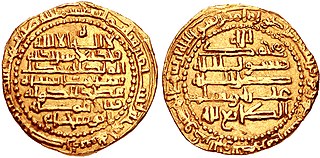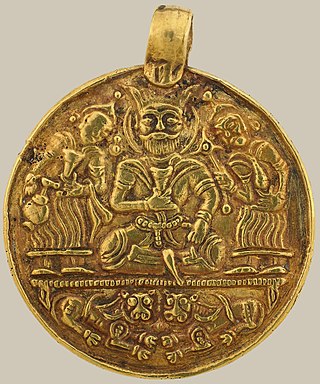Related Research Articles

Abu Bakr ʿAbd al-Karīm ibn al-Faḍl, better known by his regnal name al-Ṭāʾiʿ liʾllāh/biʾllāh, was the Abbasid caliph of Baghdad from 974 to his deposition in 991. He was in office during the domination of Iraq by the Shi'a Buyid dynasty, and as a result is generally considered a powerless figurehead under the thumb of the Buyid emirs. His tenure was also marked by strife between rival Buyid rulers and the frequent change of hands of Baghdad: al-Ta'i' himself was raised to the throne by a rebel Turkic general, Sabuktakin, who deposed al-Ta'i's father, al-Muti'. During periods of such strife, al-Ta'i' was able to exert some measure of political independence, but under stronger rulers he was sidelined, and was obliged to marry the daughters of the emirs Izz al-Dawla and Adud al-Dawla. Al-Ta'i's status suffered under Adud al-Dawla in particular, who turned to pre-Islamic Persian models for legitimacy, and relegated Iraq to the status of a simple province ruled from Fars. Al-Ta'i' was deposed on 22 November 991 by Baha al-Dawla, and replaced with his cousin, al-Qadir. He spent the rest of his days, until his death in 1003, confined to the caliphal palace.

Bakhtiyar, better known by his laqab of Izz al-Dawla, was the Buyid amir of Iraq (967–978).

Hasan, better known by his laqab as Rukn al-Dawla, was the first Buyid amir of northern and central Iran. He was the son of Buya.

Abu Mansur Buya, better known by his honorific title of Mu'ayyad al-Dawla was the Buyid amir of Hamadan (976–983), Jibal (977–983), Tabaristan (980–983), and Gorgan (981–983). He was the third son of Rukn al-Dawla.

Fannā (Panāh) Khusraw, better known by his laqab of ʿAḍud al-Dawla was an emir of the Buyid dynasty, ruling from 949 to 983, and at his height of power ruling an empire stretching from Makran to Yemen and the shores of the Mediterranean Sea. He is widely regarded as the greatest monarch of the dynasty, and by the end of his reign he was the most powerful ruler in the Middle East.
Al-Mada'in was an ancient metropolis situated on the Tigris in what is now Iraq. It was located between the ancient royal centers of Ctesiphon and Seleucia, and was founded by the Sasanian Empire. The city's name was used by Arabs as a synonym for the Sasanian capital of Ctesiphon, in a tradition that continued after the Arab conquest of Iran.
Uddat al-Dawla Abu Taghlib Fadl Allah al-Ghadanfar al-Hamdani, usually known simply by his kunya as Abu Taghlib, was the third Hamdanid ruler of the Emirate of Mosul, encompassing most of the Jazira.
Abu Bakr Muhammad ibn Ra'iq, usually simply known as Ibn Ra'iq, was a senior official of the Abbasid Caliphate, who exploited the caliphal government's weakness to become the first amir al-umara of the Caliphate in 936. Deposed by rival Turkish military leaders in 938, he regained the post in 941 and kept it until his assassination in February 942.
Ruzbahan ibn Vindadh-Khurshid, better known as Ruzbahan, was a Daylamite military officer who served the Buyid dynasty. A native of Daylam, Ruzbahan began serving the Buyids at an unknown date and quickly rose into high ranks. After constant pressure from king Mu'izz al-Dawla to conquer Batihah, he, along with his two brothers, started a rebellion lasting from 955 to 957. After the end of the rebellion, Ruzbahan was imprisoned and shortly executed.
Abu Mansur Muhammad ibn 'Abd al-Razzaq ibn 'Abdallah ibn Farrukh, also simply known as Abu Mansur Muhammad and Ibn 'Abd al-Razzaq, was an Iranian aristocrat who served the Samanids during the most of career, and briefly served as governor of Azerbaijan under the Buyids.
Abu'l-Wafa Tuzun, commonly known as Tuzun, was a Turkish soldier who served first the Iranian ruler Mardavij ibn Ziyar and subsequently the Abbasid Caliphate. Rising to a position of leadership in the Abbasid army, he evicted the Hamdanid Nasir al-Dawla from Baghdad and assumed the position of amir al-umara on 31 May 943, becoming the Caliphate's de facto ruler. He held this position until his death in August 945, a few months before Baghdad, and the Abbasid Caliphate with it, came under the control of the Buyids.
Ali ibn Kama, the nephew of the Buyid ruler Rukn al-Dawla and the latter's other brothers Mu'izz al-Dawla and Imad al-Dawla, was a Buyid military officer who became prominent among the Buyids of Jibal, and was greatly honored among his Daylamite kinsmen. At the death of Imad al-Dawla in 949, Ali was appointed as the viceroy of Ray by Rukn al-Dawla, who went to Shiraz to secure the succession of his son there, Adud al-Dawla. Meanwhile, the Samanids used this opportunity to invade the territories of Rukn al-Dawla, forcing Ali to flee from Jibal. About 959, a battle ensured between Ali and the Ziyarid prince Bisutun, which resulted in a Buyid victory. In 966, Ali and Rukn al-Dawla defeated a large force of ghazis who had arrived from Khorasan. Rukn al-Dawla later died in 976 and was succeeded by his son Fakhr al-Dawla, who had Ali executed.
Ispahdost or Isfahdust, was a Daylamite military officer who served the Buyid dynasty. He first appears as an officer of the Buyid ruler Mu'izz al-Dawla during his conquest of Abbasid Iraq in 945. Furthermore, Ispahdost is later mentioned as the brother-in-law of Mu'izz al-Dawla, and one year later, participated in the defense of Baghdad against the Hamdanids. In 948, Ispahdost, along with the Abbasid caliph al-Muti, planned a plot against Mu'izz al-Dawla, which, however, Mu'izz al-Dawla became informed of, and had Ispahdost imprisoned, who soon died.
Mansur ibn Qara-Tegin, commonly known after his father as Ibn Qaratakin was a Turkic military officer of the Samanids in the mid-10th century.
Abu Mansur Lashkarwarz ibn Sahlan, better known as simply Lashkarwarz, was a Daylamite military officer who served the Buyid dynasty. He was the son of a certain Sahlan, and had a brother named Musafir. Lashkarwarz is first mentioned in participating in the army of the Buyid vizier Abu Muhammad al-Hasan al-Muhallabi in the defense of Basra against the Wajihid ruler of Oman, Yusuf ibn Wajih. In 954, Lashkarwarz was sent to aid the Muhtajid ruler Abu 'Ali Chaghani, whose claims to Samanid Khorasan was supported by the Buyids. However, this attempt turned fruitless, and Abu 'Ali died one year later of disease. Lashkarwarz also had a daughter who married the son of the Buyid ruler Mu'izz al-Dawla, Izz al-Dawla. Lashkarwarz along with his brother died in 958.
Alptakin was a Turkish military officer of the Buyids, who participated, and eventually came to lead, an unsuccessful rebellion against them in Iraq from 973 to 975. Fleeing west with 300 followers, he exploited the power vacuum in Syria to capture several cities, including Damascus. For the next three years, Alptakin withstood attempts by the Fatimid Caliphate to capture Damascus, until he was defeated and captured by Caliph al-Aziz Billah. Taken to Egypt and incorporated into the Fatimid army, he was poisoned by the vizier Ibn Killis shortly after this.
Kurkir ibn Justan was an Iranian military officer, a Daylamite military officer of the Buyids, who served as the chief captain of the army of Kirman from 968 until his downfall in 972.
Abu Ishaq Ibrahim, also known by his honorific title of Umdat al-Dawla, was a Buyid prince, who was the youngest son of the Buyid ruler Mu'izz al-Dawla.
Abu Abdallah al-Hasan al-Baridi was the most prominent of the Baridi family, Iraqi tax officials who used the enormous wealth gained from tax farming to vie for control of the rump Abbasid Caliphate in the 930s and 940s.

The Battle of al-Mada'in was fought near al-Mada'in in central Iraq between the armies of the Hamdanids and the Baridis, for control over Baghdad, the capital and seat of the Abbasid Caliphate, that was around 22 kilometres (14 mi) away and then under control of the Hamdanids. In a fiercely contested battle over four days that cost both sides many casualties, the Hamdanid army prevailed. They were too exhausted to pursue, however, which allowed the Baridis to withdraw to Wasit and then Basra.
References
- ↑ Amedroz & Margoliouth 1921, p. 302.
- 1 2 Amedroz & Margoliouth 1921, pp. 422–423.